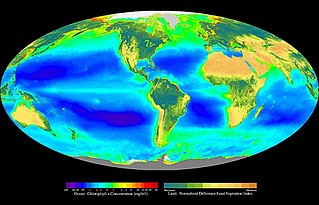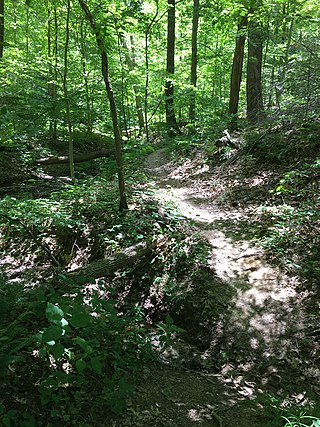
Evapotranspiration (ET) is the combined processes which move water from the Earth's surface into the atmosphere. It covers both water evaporation and transpiration. Evapotranspiration is an important part of the local water cycle and climate, and measurement of it plays a key role in agricultural irrigation and water resource management.
Sensible heat is heat exchanged by a body or thermodynamic system in which the exchange of heat changes the temperature of the body or system, and some macroscopic variables of the body or system, but leaves unchanged certain other macroscopic variables of the body or system, such as volume or pressure.

In ecology, primary production is the synthesis of organic compounds from atmospheric or aqueous carbon dioxide. It principally occurs through the process of photosynthesis, which uses light as its source of energy, but it also occurs through chemosynthesis, which uses the oxidation or reduction of inorganic chemical compounds as its source of energy. Almost all life on Earth relies directly or indirectly on primary production. The organisms responsible for primary production are known as primary producers or autotrophs, and form the base of the food chain. In terrestrial ecoregions, these are mainly plants, while in aquatic ecoregions algae predominate in this role. Ecologists distinguish primary production as either net or gross, the former accounting for losses to processes such as cellular respiration, the latter not.

A biogeochemical cycle, or more generally a cycle of matter, is the movement and transformation of chemical elements and compounds between living organisms, the atmosphere, and the Earth's crust. Major biogeochemical cycles include the carbon cycle, the nitrogen cycle and the water cycle. In each cycle, the chemical element or molecule is transformed and cycled by living organisms and through various geological forms and reservoirs, including the atmosphere, the soil and the oceans. It can be thought of as the pathway by which a chemical substance cycles the biotic compartment and the abiotic compartments of Earth. The biotic compartment is the biosphere and the abiotic compartments are the atmosphere, lithosphere and hydrosphere.

The eddy covariance is a key atmospheric measurement technique to measure and calculate vertical turbulent fluxes within atmospheric boundary layers. The method analyses high-frequency wind and scalar atmospheric data series, gas, energy, and momentum, which yields values of fluxes of these properties. It is a statistical method used in meteorology and other applications to determine exchange rates of trace gases over natural ecosystems and agricultural fields, and to quantify gas emissions rates from other land and water areas. It is frequently used to estimate momentum, heat, water vapour, carbon dioxide and methane fluxes.

Yatir Forest is a forest in Israel on the edge of the Negev Desert. The forest covers an area of 30,000 dunams, and is the largest planted forest in Israel.

LI-COR Biosciences is an international biotech company which designs, manufactures, and markets instruments, measurement systems, and software for biological and environmental research, and develops relevant measurement methodologies and techniques.
Microscale meteorology or micrometeorology is the study of short-lived atmospheric phenomena smaller than mesoscale, about 1 kilometre (0.6 mi) or less. These two branches of meteorology are sometimes grouped together as "mesoscale and microscale meteorology" (MMM) and together study all phenomena smaller than synoptic scale; that is they study features generally too small to be depicted on a standard weather map. These include small and generally fleeting cloud "puffs" and other small cloud features. Microscale meteorology controls the most important mixing and dilution processes in the atmosphere. Important topics in microscale meteorology include heat transfer and gas exchange between soil, vegetation, and/or surface water and the atmosphere caused by near-ground turbulence. Measuring these transport processes involves use of micrometeorological towers. Variables often measured or derived include net radiation, sensible heat flux, latent heat flux, ground heat storage, and fluxes of trace gases important to the atmosphere, biosphere, and hydrosphere.

Morgan–Monroe State Forest is a state forest in Morgan County and Monroe County of Indiana, and is the second largest state forest in Indiana. The 24,000 acres (97 km2) comprising this deciduous forest was abandoned farmland, as the previous residents realized that the land's rocky soil was very poor for agricultural purposes. In 1929 the state of Indiana purchased the land to prevent further erosion and to create the state forest.
The following are considered ocean essential climate variables (ECVs) by the Ocean Observations Panel for Climate (OOPC) that are currently feasible with current observational systems.

The Integrated Carbon Observation System (ICOS) is a research infrastructure to quantify the greenhouse gas balance of Europe and adjacent regions. In November 2015 it received the international legal status of ERIC (European Research Infrastructure Consortium) by decision of the European Commission. It is recognized by The European Strategy Forum on Research Infrastructures (ESFRI) as a landmark European research infrastructure. It consists of a harmonized network of almost 150 long-term observation sites for the domains of atmosphere, ecosystems and ocean. The network is coordinated through its Head Office, the central data portal and central facilities including an atmosphere, ecosystem and ocean thematic center, and central analytical laboratories.
The Hawaii Ocean Time-series (HOT) program is a long-term oceanographic study based at the University of Hawaii at Manoa. In 2015, the American Society for Microbiology designated the HOT Program's field site Station ALOHA a "Milestone in Microbiology", for playing "a key role in defining the discipline of microbial oceanography and educating the public about the vital role of marine microbes in global ecosystems."
Soil gases are the gases found in the air space between soil components. The spaces between the solid soil particles, if they do not contain water, are filled with air. The primary soil gases are nitrogen, carbon dioxide and oxygen. Oxygen is critical because it allows for respiration of both plant roots and soil organisms. Other natural soil gases include nitric oxide, nitrous oxide, methane, and ammonia. Some environmental contaminants below ground produce gas which diffuses through the soil such as from landfill wastes, mining activities, and contamination by petroleum hydrocarbons which produce volatile organic compounds.

Ecosystem respiration is the sum of all respiration occurring by the living organisms in a specific ecosystem. The two main processes that contribute to ecosystem respiration are photosynthesis and cellular respiration. Photosynthesis uses carbon-dioxide and water, in the presence of sunlight to produce glucose and oxygen whereas cellular respiration uses glucose and oxygen to produce carbon-dioxide, water, and energy. The coordination of inputs and outputs of these two processes creates a completely interconnected system, constituting the underlying functioning of the ecosystems overall respiration.

George Burba is an American bio-atmospheric scientist, author, and inventor.

Lake metabolism represents a lake's balance between carbon fixation and biological carbon oxidation. Whole-lake metabolism includes the carbon fixation and oxidation from all organism within the lake, from bacteria to fishes, and is typically estimated by measuring changes in dissolved oxygen or carbon dioxide throughout the day.

Net ecosystem production (NEP) in ecology, limnology, and oceanography, is the difference between gross primary production (GPP) and net ecosystem respiration. Net ecosystem production represents all the carbon produced by plants in water through photosynthesis that does not get respired by animals, other heterotrophs, or the plants themselves.
Kimberly A. Novick is an environmental scientist and an Associate professor at Indiana University, Bloomington. Her research mostly includes the study of land-atmosphere interactions. She received the Thomas Hilker Early Career Award in Biogeosciences from American Geophysical Union (AGU) in 2019.
Beverly Law is an American forest scientist. She is professor emeritus at Oregon State University known for her research on forest ecosystems, especially with respect to carbon cycling, fire, and how human actions impact future climate.

Elise Gislaine Pendall is an American soil and ecosystem ecologist who is a professor at Western Sydney University. She studies how biogeochemical cycling responds to climate change and disturbances to the ecosystem.














